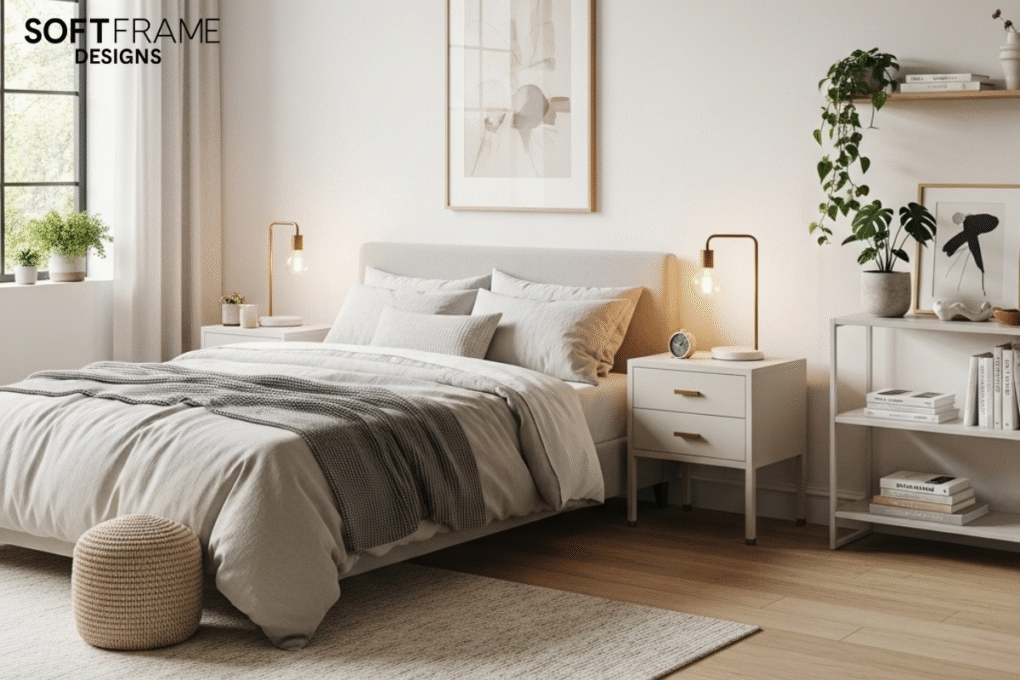
Most people approach bedroom setup by buying furniture randomly, then wondering why their space feels incomplete or uncomfortable. The bedroom furniture industry doesn’t help; they promote endless “must-have” items that clutter spaces without improving function.
The truth? A well-designed bedroom needs specific essentials that work together to create comfort, support good sleep, and provide adequate storage. Here’s what actually matters when creating a bedroom that functions properly.
Bedroom Essentials That Actually Matter
- Quality mattress and bed frame: Foundation for good sleep and room design
- Functional storage: Dresser, nightstands, and organized closet space
- Proper lighting: Multiple light sources for different activities and moods
- Climate control: Window treatments and ventilation for comfort
- Personal comfort items: Rugs, seating, and accessories that make the space yours
- Organization systems: Solutions that prevent clutter and maintain order
Essential Bedroom Furniture
Start with furniture pieces that serve multiple purposes and provide long-term value rather than trendy items that quickly become outdated.
The Bed: Your Most Important Investment
A quality bed frame with a headboard creates the room’s focal point while providing essential support for your mattress. The bed frame affects both comfort and aesthetics, making it worthwhile to invest in solid construction that lasts.
Mattress considerations: Choose firmness based on sleep position and personal preference. Side sleepers typically need softer surfaces, while back sleepers benefit from medium-firm support. Replace mattresses every 7-10 years for optimal sleep quality.
Size planning: Ensure adequate walking space around the bed. King beds need larger rooms to avoid cramped feelings, while queen beds work well in most standard bedrooms.
Storage Solutions That Work
- Nightstands: Place matching nightstands on both sides of the bed for balance and convenience. Look for options with drawers or shelves to reduce bedside clutter.
- Dresser placement: Position dressers away from foot traffic areas but within easy reach of the closet. Vertical storage maximizes floor space in smaller bedrooms.
- Under-bed storage: Utilize this often-wasted space with storage boxes or bed frames with built-in drawers. Keep seasonal items or extra bedding here.
Bedding and Comfort Essentials
| Item | Purpose | Quality Indicators |
| Fitted Sheet | Mattress protection and comfort | Deep pockets, quality material |
| Flat Sheet | Temperature regulation | Breathable fabric, proper size |
| Pillows | Neck and spine support | Adjustable fill, washable covers |
| Duvet/Comforter | Warmth and style | Appropriate fill weight, washable |
Bedding Material Selection
Cotton bedding: Breathable and easy to care for, cotton works well for most climates. Higher thread counts feel softer but aren’t always better – 200-400 thread count provides a good balance of softness and durability.
Linen options: More expensive but excellent for temperature regulation. Linen develops character over time and works well in modern bedroom designs.
Pillow selection: Choose pillows based on sleep position. Side sleepers need firmer, thicker pillows, while stomach sleepers require thinner options to maintain proper alignment.
Lighting Strategy
Bedrooms need multiple light sources to support different activities throughout the day and evening.
Essential Lighting Types
Overhead lighting: Provides general illumination for cleaning and getting dressed. Install dimmer switches to control intensity throughout the day.
Bedside lighting: Table lamps or wall-mounted lights enable reading without disturbing a partner. Position lights to minimize shadows on reading material.
Ambient lighting: Floor lamps or accent lights create relaxing atmosphere for evening wind-down routines.
Light Control Solutions
Window treatments: Blackout curtains or blinds help control natural light and improve sleep quality. Layer sheers curtains with heavier curtains for light flexibility throughout the day.
Light timing: Consider smart bulbs or timers that gradually dim evening light to support natural sleep rhythms.
Climate and Comfort Control
Air circulation: Ensure adequate ventilation through windows or fans. Stuffy bedrooms disrupt sleep quality and create uncomfortable environments.
Temperature management: The ideal bedroom temperature ranges from 65°F to 68°F for most people. Layer bedding to adjust warmth rather than relying solely on thermostat control.
Humidity control: Maintain 30-50% humidity for comfort. Too dry causes skin and respiratory irritation, while too humid promotes mold growth.
Organization and Storage Systems
Closet organization: Maximize space with proper hangers, shelving, and drawer systems. Group similar items together and store out-of-season clothes separately.
Surface management: Keep nightstand and dresser tops clear except for daily essentials. Designate specific spots for items like jewelry, charging cables, and reading materials.
Laundry system: Establish clear areas for clean and dirty clothes to prevent bedroom chaos. Hampers with lids contain odors while maintaining appearance.
Flooring and Comfort Additions
Area rugs: Place rugs strategically for warmth and comfort underfoot. Large rugs that extend beyond the bed create cohesive appearance while smaller rugs work well beside the bed.
Rug materials: Wool rugs provide durability and natural stain resistance. Synthetic options offer budget-friendly alternatives that handle high-traffic areas well.
Seating options: Include a chair or bench if space allows. This provides a place to sit while putting on shoes and keeps clothes off the bed.
Personal Touches and Decor
Artwork selection: Choose pieces that promote calm feelings rather than energizing images. Bedroom art should support relaxation and rest.
Plant additions: Include low-maintenance plants that thrive in bedroom conditions. Snake plants and pothos work well in lower light while improving air quality.
Personal items: Display meaningful objects sparingly to avoid clutter while maintaining a personal connection to the space.
Room Layout Optimization
Traffic flow: Ensure clear pathways around the bed and to the closet. Cramped layouts create stress and make daily routines more difficult.
Furniture placement: Position the bed as the room’s focal point, typically against the longest wall. Leave equal space on both sides when possible.
Scale considerations: Select furniture that is proportionate to the room’s size. Oversized pieces overwhelm small spaces, while tiny furniture gets lost in large rooms.
Expert Design Insight
According to the American Sleep Association, bedroom environment significantly impacts sleep quality, with clutter and poor lighting being primary disruptors. Interior design specialist Maria Rodriguez notes: “The most beautiful bedroom becomes useless if it doesn’t support the activities that happen there – primarily sleep and relaxation.”
This research highlights the importance of functional design over following decorating trends that may not support actual bedroom use.
Budget-Smart Shopping Strategy
Invest in quality basics: Spend more on items used daily like mattresses, pillows, and sheets. These directly affect comfort and sleep quality.
Save on decorative items: Artwork, throw pillows, and accessories can be budget-friendly since they’re easily replaced when tastes change.
Timing purchases: Buy bedding during white sales and furniture during end-of-season clearances for significant savings.
Working with established retailers ensures access to high-quality options and reliable customer service. SoftFrame Designs specializes in bedroom furniture that strikes a balance between style and functionality, offering guidance for creating cohesive and comfortable spaces.
Creating Your Ideal Bedroom
Start with function: Identify how you actually use your bedroom beyond sleeping. Reading, getting dressed, and relaxing all require different furniture and lighting considerations.
Plan for growth: Choose neutral, quality pieces that adapt to changing styles and life circumstances rather than trendy items that quickly feel dated.
Test comfort: Take the time to evaluate mattresses, pillows, and seating before making a purchase. Comfort preferences are highly individual and affect long-term satisfaction.
Maintain simplicity: Resist the urge to fill every space. Empty areas provide visual rest and make rooms feel larger and more peaceful.
A well-designed bedroom supports both physical comfort and mental well-being. Taking the time to choose the right essentials creates a space that truly serves as a restful retreat from daily stress.
Frequently Asked Questions
- What furniture do I absolutely need in my bedroom? Essential furniture includes a quality bed frame and mattress, at least one nightstand, and adequate storage like a dresser. Everything else can be added based on space and personal needs, but these basics provide the foundation for a functional bedroom.
- How much should I spend on bedroom essentials? Invest most heavily in items that affect sleep quality – mattress, pillows, and quality sheets. These items are used daily and directly impact health and comfort. Decorative elements can be budget-friendly since they’re easily updated over time.
- What’s the best way to arrange bedroom furniture? Position the bed as the focal point against the longest wall, leaving equal space on both sides when possible. Ensure clear pathways to the closet and door, and place the dresser where it’s accessible but doesn’t block traffic flow.
